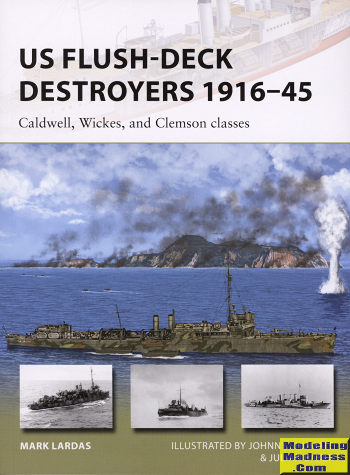 When
the US entered WWI, it was deficient in all manner of materiel with which to
wage war. That included destroyers. A huge building program got underway to
provide what was needed and these ships were farmed out to several ship yards
for construction. Eventually, 377 ships were built in three very similar
classes. These were the Caldwell, Wickes, and Clemson classes.
When
the US entered WWI, it was deficient in all manner of materiel with which to
wage war. That included destroyers. A huge building program got underway to
provide what was needed and these ships were farmed out to several ship yards
for construction. Eventually, 377 ships were built in three very similar
classes. These were the Caldwell, Wickes, and Clemson classes.
Unlike other nation's destroyers, these ships did not have a prominent,
raised forecastle. Tests had shown there was no need. They were armed with four
4.7 inch guns in open mounts with two triple torpedo tubes. They were also
designed to make 36 knots, fast enough to keep up with the battle fleet. In
addition, they were oil fired and turbine powered. Most had geared prop shafts,
but not all. In fact, each ship yard was able to choose the main equipment for
these ships. This led to some difficulties. Specifically, some were considerably
slower than others.
These ships were also woefully under-gunned when it came to
anti-aircraft protection and they were not initially equipped to hunt
submarines. These were the days prior to SONAR, though there were underwater
listening devices. The ships also had a knife-edge stern which made it difficult
to mount depth charge racks. One of the many modifications was the installation
of the square 'porch' on the back of these ships to allow these racks to be
carried.
Such was the pace of building, that only a very few of these ships
actually saw any service in WWI. Despite the end of the war, the rest of the
fleet was built with the last of them being commissioned in 1921.
At the end of the war, there was a bit of a problem. Such was the
drawdown in forces that the USN had all these ships and not enough people
to man them. Many of them were put into ready reserve, some were operated with
half crews and others had crews switch between two ships just to keep them up
and running. With the advent of the various naval treaties, a number of them
were scrapped or repurposed. Some were used as test ships while others became
auxilliaries. A few became minesweepers and others became light seaplane
tenders.
With the start of WWII, 50 of them were provided to the British under
lend-lease. These ships were outfitted as convoy escorts. This often meant the
replacement of one of the four boilers and stacks by fuel tanks to extend the
range. In the US, having all these destroyers was a blessing. These ships were
obsolescent at best and many were converted to fast transports, minesweepers and
other ship types, vital to the war effort. They allowed the newer destroyers to
be used in their intended role. Often it meant the removal of one or more
boilers, but then endurance was more of a requirement, especially when used as
convoy escorts. They just had to be faster than the submarines.
These ships had a wide and distinguished war career, especially in the
Pacific. In the early years they were a large part of the Asiatic fleet and
helped fight the Japanese with some success. Others were used to transport
Marine raiding forces, supply coast watchers and to bring provisions to troops
on contested islands where speed in and out was important.
Eventually, most were replaced by late 1944 though many were still in
service until the end of the war. All of these ships, even though provided to
the UK or USSR were scrapped by 1950, leaving none for museums. However, they
had done their job and more. Without them, the war would have been a bit more
difficult for the Allies.
Besides being my favorite Osprey series, this one is a superb look at
these important ships and is a book you really need to have on your shelves.
May 2018
Copyright ModelingMadness.com. All rights reserved
For more on the complete line of Osprey books, visit
http://www.ospreypublishing.com
If you would like your product reviewed fairly and
fairly quickly, please
contact
the editor or see other details in the
Note to
Contributors.
 When
the US entered WWI, it was deficient in all manner of materiel with which to
wage war. That included destroyers. A huge building program got underway to
provide what was needed and these ships were farmed out to several ship yards
for construction. Eventually, 377 ships were built in three very similar
classes. These were the Caldwell, Wickes, and Clemson classes.
When
the US entered WWI, it was deficient in all manner of materiel with which to
wage war. That included destroyers. A huge building program got underway to
provide what was needed and these ships were farmed out to several ship yards
for construction. Eventually, 377 ships were built in three very similar
classes. These were the Caldwell, Wickes, and Clemson classes.